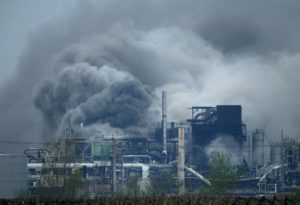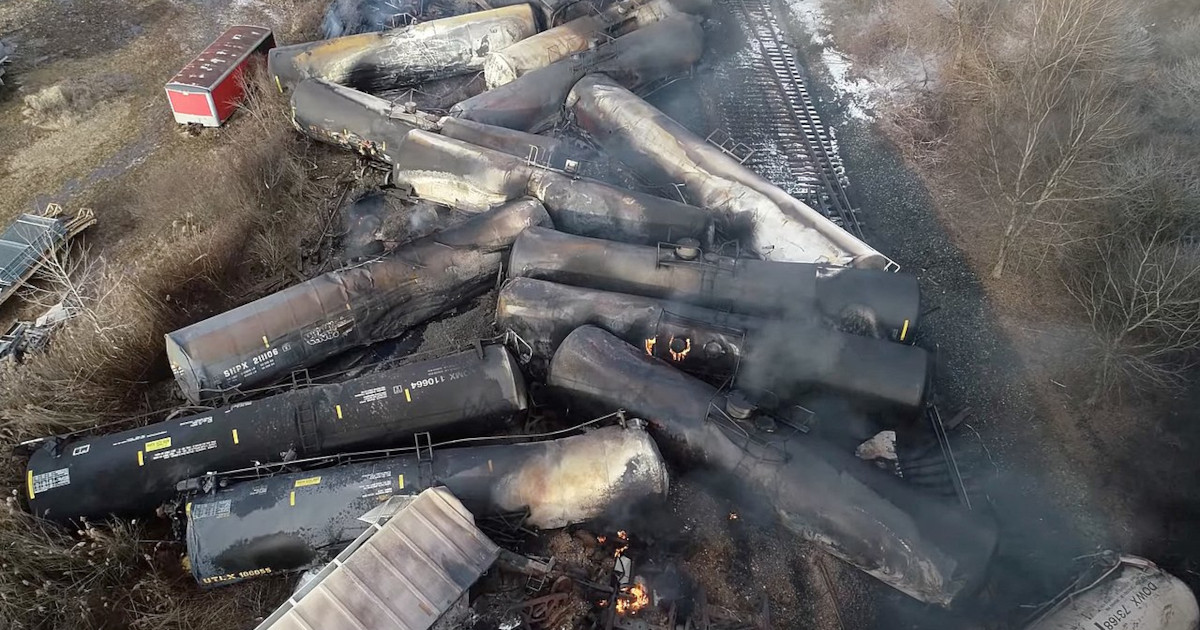UPDATE: In response to advocacy from community members in East Palestine, advocates, scientists, and elected officials, on March 2, 2023, the U.S. EPA announced that it will require Norfolk Southern to sample for dioxins in East Palestine. Read Toxic-Free Future’s twitter thread for additional insights.
The vinyl chloride train derailment in Ohio is a modern environmental disaster playing out in real time. Sadly, this is yet another painful reminder of the dangers of making, transporting, using, and disposing of chemicals in plastics, especially polyvinyl chloride (PVC) plastic. PVC is widely considered to be the most toxic plastic from production to use to disposal. It’s most commonly used in building materials like PVC plastic piping and vinyl siding.
We need a thorough investigation into vinyl chloride, dioxins, and other hazardous chemicals
This is not the first time an accident involving hazardous vinyl chloride has occurred. The U.S. Environmental Protection Agency (EPA) should be applying the lessons learned, particularly with comprehensive testing and monitoring of air, water, soil, farms and livestock, and homes.
One critical lesson is that EPA should be testing for dioxins, a highly hazardous class of chemicals. We’ve seen elevated levels of dioxins released in industrial accidents involving chlorinated chemicals—from the explosion at the PVC plant in Illiopolis, Illinois to the Plastimet PVC recycling fire in Ontario. But without a comprehensive investigation, we will not know if dioxins are also a concern in the East Palestine vinyl chloride disaster.
Over the last week, the EPA has repeatedly suggested that the disaster area is safe for residents to return home, but to date, the EPA has not publicly released any data on dioxins, persistent chemicals that build up in the food chain and can cause cancer and other serious health problems. It appears that EPA has not yet conducted any sampling for dioxins.
This is deeply concerning, as we know that burning chlorinated chemicals like vinyl chloride, especially in uncontrolled conditions as was done in East Palestine, is a perfect recipe for dioxin formation.
It is critical that the EPA significantly expand the scope of its testing, with strong input from local communities, and launch a comprehensive multi-media investigation into the possible release of dioxins and other toxic byproducts from the disaster.
As a next step, the EPA should work with and seek input from the impacted communities to immediately develop and implement plans to:
- Test for dioxins and other byproducts in soils at homes, parks, schools, farms, and other locations
- Screen for dioxins and other byproducts in indoor dust
- Monitor dioxins and other byproducts in farm animals, milk, and eggs in farms downwind of the explosion
Other experts agree and are joining the call for an investigation into dioxins. For example, Cornell University soil and crop scientist Murry McBride recently stated: “It is advisable that farmers and other residents in this area test their wells over the next few months at least for the presence of the spilled chemicals including vinyl chloride, in order to protect the health of humans and livestock. Because the combustion of vinyl chloride that resulted from the accident may have created highly toxic dioxins, surface soils downwind of the spill site should be tested for dioxin levels particularly where food crops are to be grown.”
Dioxins are among the most toxic chemicals on the planet
Dioxins are a family of chemicals that are formed from the manufacture and burning of chlorinated chemicals, like those used to make PVC plastic. They are extremely persistent, bioaccumulative, and toxic. As they are endocrine disruptors, they can be hazardous at incredibly low levels of exposure. And because they are persistent and bioaccumulative, they don’t go away for a very long time. The half-life of dioxins is estimated to be 7-11 years which means, if someone has one part of dioxin in their body, it will take 7-11 years for half of it to degrade.
Dioxins are considered carcinogens by the U.S. EPA, International Agency for Research on Cancer, and the National Toxicology Program. They can also cause many non-cancer effects on our reproductive, developmental, and immune systems. They can also lead to chloracne, a rare skin eruption.
Dioxins are notorious for being the primary contaminant in Agent Orange, and other environmental tragedies like Love Canal and Times Beach.
Will dioxins be found in the communities and farms downwind of the East Palestine derailment? Without testing, we won’t know. EPA must act now.
More details on this accident and the long history of disasters created by the vinyl plastics industry
The markings on the train cars carrying vinyl chloride in East Palestine, Ohio indicate that three of them belong to one of the biggest producers of PVC in the U.S. and world, OxyVinyls—which has a long history of community and worker safety concerns. The chemicals appear to have been traveling from OxyVinyls’ plant in Deer Park, Texas to their facility in Niagara Falls, Ontario. Some of the other cars belonged to another PVC producer, Shintech, and, according to the manifest, they contain “polyvinyl.” It is unclear if that indicates PVC pellets. If so, that would only add to the dioxin concern.
This is not the first time we’ve seen a massive accident from transporting and making vinyl plastics. Time and time again, the vinyl plastics industry has impacted frontline environmental justice communities and workers, exposing them to cancer-causing chemicals like vinyl chloride, ethylene dichloride, and dioxins.

For instance:
- In Paulsboro, NJ: Train cars carrying vinyl chloride derailed in 2012, releasing a toxic plume of vinyl chloride into the community. Many first responders and area residents complained of health problems believed to be attributable to vinyl chloride exposure.
- In Illiopolis, IL: A PVC plastics plant that made vinyl flooring exploded in 2004, killing workers and releasing a plume of toxic chemicals. A federal investigation found the chemical plant owner was, “aware of the possibility of serious consequences of an inadvertent release of chemicals from an operating PVC reactor” and found they did not take sufficient action to prevent an accident. Sampling from the Illinois EPA documented elevated concentrations of dioxins in 12 out of 13 soil samples downwind of the fire.
- In Mossville, Louisiana: With more vinyl production facilities than anywhere else in the U.S. and surrounding a predominantly African American community, the location of these facilities has been a classic case of environmental racism. Testing by ATSDR documented elevated levels of dioxins in the blood of Mossville residents above federal averages. Dioxins were also found in the eggs in the community. Over the years, most of the community has been relocated due to contamination.
Why PVC plastic has a toxic lifecycle
The risks of transporting highly flammable and deadly vinyl chloride is just one of the numerous risks associated with making, using, and releasing highly toxic PVC vinyl plastic.
The process of making chlorine for PVC plastic uses highly hazardous chemicals and membranes including chlorine gas, PFAS, asbestos, and mercury. PVC plants use and release dangerous chemicals to make the plastic, including the carcinogens vinyl chloride and ethylene dichloride. In China, where an estimated 34% of all PVC is made today, the industry uses a different process that uses massive amounts of mercury, contributing to global warming and carbon dioxide pollution.
PVC is also often filled with a witch’s brew of toxic additives. To make vinyl plastics soft and flexible, ortho-phthalates are added, hormone-disrupting chemicals that can impact reproductive health and have been linked to asthma and developmental problems. Metals such as lead, cadmium, and organotins have often been used as stabilizers to prevent degradation. Toxic organohalogen flame retardants, like chlorinated paraffins, are also often added. Here’s the problem: these additives are not typically chemically bound to the plastic which means they can leach out, exposing people to the chemicals. Once in indoor air and household dust, they can also migrate into the environment where water, wildlife, and food is impacted.
Most PVC is not recycled, ending up in landfills and incinerators. The combustion of PVC can form dioxins. Small fragments of PVC called microplastics can end up in the ocean where they can release phthalates and other toxic additives, posing risks to fish and wildlife.
Because of this toxic lifecycle, it’s only a matter of time before we see another crisis like the East Palestine, Ohio train derailment disaster. To keep this from happening again, it is critical that we prevent PVC production, use, and disposal.
What needs to happen to prevent future disasters
Governments, retailers, and brands must redouble their efforts to phase out PVC plastic and other highly hazardous plastics and chemicals and move towards safer solutions.
In the meantime, for the health and well-being of communities, farmers, and workers downwind of this most recent disaster, EPA must move quickly to expand its investigation and sample for dioxins and other toxic byproducts that were likely released.
Ohio train derailment disaster: Connect with local groups
If you are concerned about the massive vinyl chloride train derailment near the Ohio/Pennsylvania border that occurred in February 2023, grassroots groups responding to the disaster in the region you may want to connect with include:





